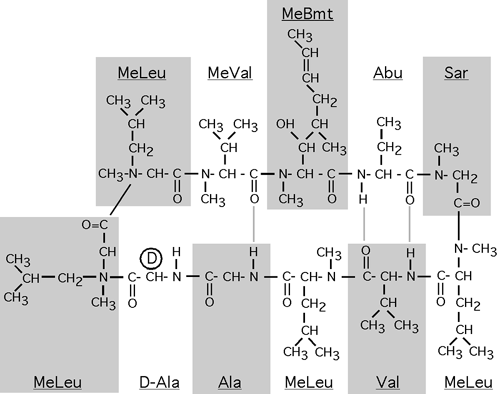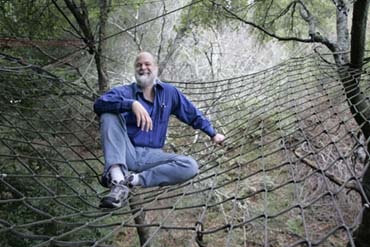Round it goes

Cyclosporin is famous for its use in transplant surgery, where it suppresses the immune system to prevent rejection. It is made by the fungus Tolypocladium inflatum as a defensive weapon, as are many of our common antibiotics, such as penicillin.
As you can see, it gets its name from its chemical structure. It is made of eleven amino acids that form a closed loop. Short chains of amino acids are called peptides, and longer ones are called proteins.
Loops of amino acids (called cyclic peptides), have several features that make them especially interesting. Because they have no dangling ends for digestive enzymes to grab onto, they don't degrade easily, and thus can be taken orally. They hold their shape better than non-cyclic peptides, making them more specific in their interactions, since they can't deform to fit where they aren't wanted (an important feature in biology). They can withstand higher temperatures and acidity, since they don't break down as easily. Proteins usually denature when heated, changing their structure dramatically, as in egg white when it is cooked. Cyclic peptides and proteins are much more stable.
The stability of cyclic proteins can be further increased by linking the amino acids inside the loop together, forming ladder-like stuctures, webs, and knots.
The stability and specificity of cyclic proteins makes them especially useful to organisms, as they can remain active in many environments, are difficult for a pathogen to degrade, and can target their activity to reduce side effects.
One cyclic protein of interest is rhesus theta-defensin-1. It is a protein found in some primates which gives them a defense against HIV. Cyclic proteins have not yet been found in humans, but a genetic sequence similar to rhesus theta-defensin-1 has been found, with a small mutation (a premature stop codon) that prevents it from forming the full protein. Analyzing this sequence in a range of different primates shows that the mutation occurred seven to ten million years ago. If it had not been for this mutation, humans might have retained a defense against HIV to this day.

0 Comments:
Post a Comment
Links to this post:
Create a Link
<< Home